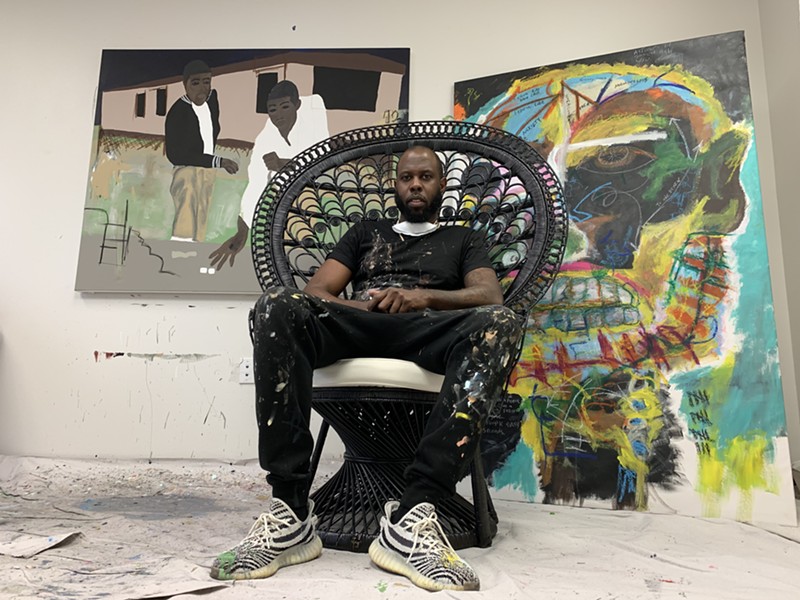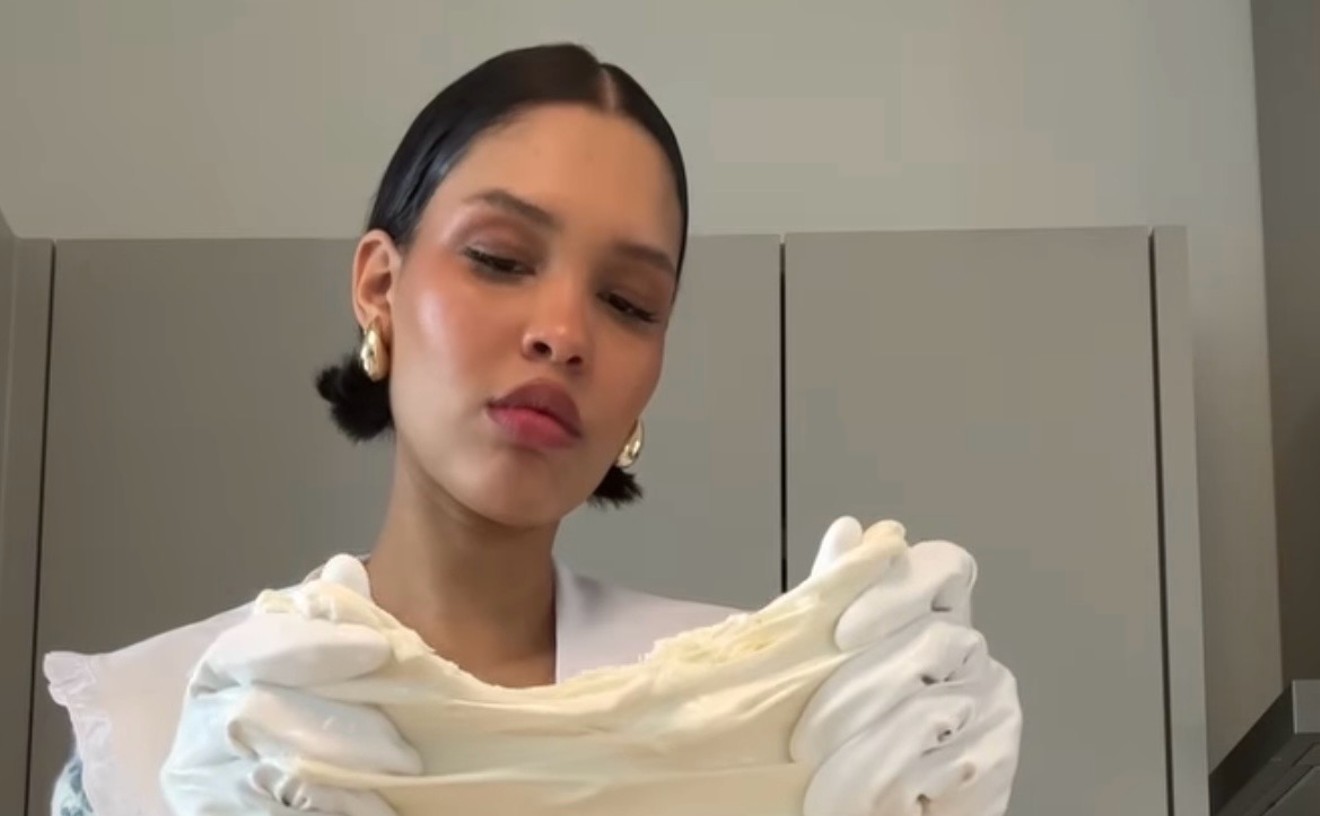The Holmes house did not have a TV. Jammie Holmes, one of the family’s two boys, found his entertainment through the thin bars of a box fan. His family’s home was a ramshackle shotgun house on the aptly named Narrow Street in Thibodaux, Louisiana. At night, under a dark Louisiana sky, Holmes’ cousins sat on Narrow Street playing cards or dice. They laughed, they smiled and Holmes watched, enraptured by the glimpses of joy he could catch through the box fan.
Holmes, now 35 and a successful painter, captures these scenes in pieces that have traveled the world. He’s shown in Atlanta, Los Angeles, Miami and New York, and one of his paintings hangs in rapper Rick Ross’ home. He has yet to show much of his work in Dallas, but he will be at Dallas Art Fair in April.
Holmes is in his studio, where he and his girlfriend, fellow artist Abi Salami, share a few rooms in a nondescript office building off Stemmons Freeway. Holmes is wearing paint-splattered Yeezys (“The sneakerheads are going to be mad at me for these”) and a grin that seldom left his face throughout the tour of the space. He walks into what he calls his “war room,” a cramped office packed with paintings in progress. The white walls are decorated by doodles from Holmes’ sons from a previous relationship, who still live in Thibodaux.
While intermittent rain falls lazily outside, the painter looks through his recent work. Though they differ drastically in content — some are political, some are whimsical, some depict child soldiers — each painting bears striking similarities. Black characters are engaged in various states of play: a card game, a game of dice, a house party. Behind them lies evidence of a life of poverty: trash-strewn rooms, discarded shotgun houses and box fans. The characters always wear blank stares that seem to convey a calm sadness, as if they are accepting the poverty that threatens to shroud the canvas. The paintings are shards of Thibodaux, Holmes says. In his words, the tiny town of 15,000 is “a city full of adults that grew up too fast.”
“Some people are born, and they get to live,” he says. “Other people have to learn how to survive. How the fuck do you figure out how to survive when you’re dealt bad cards?”
Thibodaux, Louisiana, is best known for two things: As the setting for the movie Fletch Lives, and the Thibodaux massacre. In the former, Chevy Chase’s eponymous private eye stumbles through 95 minutes of racist Southern stereotypes. The movie opened at No. 1 in the box office in 1989. In the latter, 57 black sugar cane workers were slaughtered by white militiamen in 1887. The cane cutters wanted $1 per day.
This is one of the key reasons painter Jammie Holmes (pronounced like “Jamie”) says his hometown is “sick” and “cursed” by the brutal, unwavering legacy of slavery and oppression.
“The slave homes are still standing,” he says, referring to the derelict plantation quarters in Thibodaux’s sugar cane fields. “We’ve been through hurricanes, but they’re still there.”
Holmes remembers the traumas of childhood with perfect clarity. He can recall the way his rickety house looked — so decrepit that it could crumble at any moment. Even now, he can picture the frail gaits of the crack addicts who dwelled on Narrow Street. They waited for Holmes and his friends to get out of school, then approached, asking for money, food, anything. To Holmes, this was normal.
“My whole family was from Thibodaux, so that’s our world,” he says. “We didn’t know anything else.”“We didn’t know if I was going to deal drugs, sell clothes or be an artist, but we knew I was going to do something big.” — Jammie Holmes
tweet this
He saw friends get pulled in by the ever-present allure of gangs and drugs, but Holmes resisted. He admits he “did some stupid things he’d rather not talk about,” but none of it was serious. Most of the time, he just doodled. His talent shone at an early age, and his family took notice.
“My cousin Tyrone told me, ‘You have million-dollar hands,’” Holmes recalls. “We didn’t know if I was going to deal drugs, sell clothes or be an artist, but we knew I was going to do something big.”
Years later, when Holmes was in his 20s, Tyrone was opening up a nightclub near Thibodaux. He wanted Holmes to paint something for the club.
“I had never painted before in my life,” Holmes says. “It was all drawing, all doodles. But he believed in me.”
Holmes kept procrastinating, scared of disappointing the cousin who always lauded his talent and ambitions. One night, Tyrone was driving when another driver struck his vehicle. Holmes’ first fan died.
“That broke me,” Holmes says. “I don’t think I loved my family until then, like really loved. We just didn’t show it. After that, I wanted them to know I was there. I wanted them to know they had me.”
Holmes began painting, spurred on by his grandmother. He thought his work was terrible; she told him otherwise. Just as writers are told “write what you know,” Holmes painted what he knew: family and poverty. By day, he worked in the oilfields. By night and weekend, he honed his craft, using his million-dollar hands to capture the stories of his youth. Every canvas carries remnants of trauma.
“My therapist helped me realize that,” he says. “She said, ‘Your childhood wasn’t normal. You were traumatized.’”
Now he spends most of his time trying to ensure his sons and their cousins never have to live a life like the one he had. When his paintings started getting bought by galleries and rappers, Holmes started leveraging his name for his family. Every time he prints one of his works, he gets 150 made: 100 for the public to buy, and 50 for his family.
“That way, when my name means even more, they can get that reward,” he says. “I want to put them through college.”
In 2016, Holmes moved to Dallas. He kept working and painting, and met Salami at an artists’ event in 2017. While Holmes’ work is messy, hers is controlled.
“We push each other,” Salami says of her partner. “I keep him in check, and he does the same for me.”
The pair works at the shared studio space every day, and it's a study in contrasts: Salami’s space is neat and orderly, and Holmes’ “war room” epitomizes chaos. He has a quick temper, which flares whenever he isn’t happy with a painting.
“I can’t tell you how many canvases I’ve seen him punch through,” Salami says. “It’s either that, or the knife.”
To be clear, Holmes has a knife for the sole purpose of destroying canvases. As his girlfriend shares this fun fact, Holmes giggles, flashing his toothy grin from ear to ear. Yet when it's time to take a photo, the smile disappears.
“I don’t smile in photos,” he says. “I’m like them.”
By “them” he means the characters in each of his paintings. Throughout the shoot, he dons an expression remarkably similar to the ones seen in his work.
“These are all stories,” he says of his painting. “They’re for blacks, they’re for whites, they’re for Mexicans. They’re for whoever is going to listen. When they look at it, I want them to say, ‘I get it. I really fucking get it.’”
There's only one painting in the studio where a Holmes character is smiling. The woman in the painting wears a vibrant red dress, and her beatific grin gleams against the painting’s dark background.
“That’s my mother,” Holmes says. “I was raised by women; I have to honor women in my work.”
The women in his life honor him in their own way. Holmes did not mention Rick Ross throughout our entire conversation, but he did mention his grandma. She is still alive and well, living in Thibodaux and telling everyone she can about her grandson, the artist.
“She has my doodles on her fridge,” he says, beaming. “How cool is that?”











